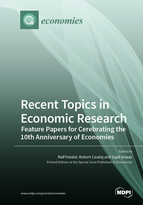Recent Topics in Economic Research – Feature Papers for Cerebrating the 10th Anniversary of Economies
A special issue of Economies (ISSN 2227-7099).
Deadline for manuscript submissions: closed (30 June 2022) | Viewed by 51507
Special Issue Editors
Interests: open economy macroeconomics; monetary theory and policy; international finance; European integration; growth and development
Special Issues, Collections and Topics in MDPI journals
Interests: applied econometrics; time series analysis; Bayesian econometrics; financial markets; exchange rates
Special Issues, Collections and Topics in MDPI journals
Interests: international national trade and finance; supply chain; carbon emissions; circular economy
Special Issues, Collections and Topics in MDPI journals
Special Issue Information
Dear Colleagues,
In 2023, Economies is celebrating its 10th anniversary. Thanks to the incredible support of all of you, the journal has developed into a well-respected academic journal. Economies has been included in several journal rankings, has a decent and growing number of submissions by well-known experts, and obtains very satisfactory citation scores given its young age. We want to acknowledge these achievements with a dedicated Special Issue. Therefore, we encourage researchers from all areas of economic research to submit abstracts for this Special Issue. We will then make a decision on each submission as to whether it will be accepted as a full manuscript for this Special Issue or as a regular paper.
Economies is an open-access journal that normally charges authors a fee. However, MDPI has agreed to publish papers that have been prepared for this important issue free of any charge.
The Special Issue is titled “Recent Topics in Economic Research”. We intend to cover a broad range of topics that are currently at the forefront of economics research matching your field of expertise and that are within Economies' scope. This includes original research papers as well as comprehensive review papers on topics that you deem of actual importance in economics.
Prof. Dr. Ralf Fendel
Prof. Dr. Robert Czudaj
Prof. Dr. Sajid Anwar
Guest Editors
Manuscript Submission Information
Manuscripts should be submitted online at www.mdpi.com by registering and logging in to this website. Once you are registered, click here to go to the submission form. Manuscripts can be submitted until the deadline. All submissions that pass pre-check are peer-reviewed. Accepted papers will be published continuously in the journal (as soon as accepted) and will be listed together on the special issue website. Research articles, review articles as well as short communications are invited. For planned papers, a title and short abstract (about 100 words) can be sent to the Editorial Office for announcement on this website.
Submitted manuscripts should not have been published previously, nor be under consideration for publication elsewhere (except conference proceedings papers). All manuscripts are thoroughly refereed through a single-blind peer-review process. A guide for authors and other relevant information for submission of manuscripts is available on the Instructions for Authors page. Economies is an international peer-reviewed open access monthly journal published by MDPI.
Please visit the Instructions for Authors page before submitting a manuscript. The Article Processing Charge (APC) for publication in this open access journal is 1800 CHF (Swiss Francs). Submitted papers should be well formatted and use good English. Authors may use MDPI's English editing service prior to publication or during author revisions.








